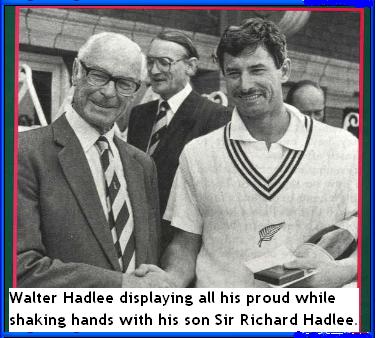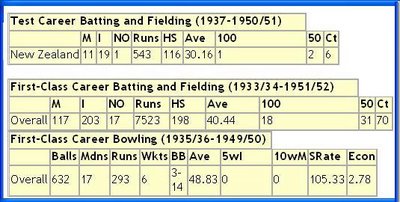 Walter Arnold Hadlee, arguably one of the New Zealand’s greatest cricketers died today, 29th September, 2006 after fighting hard for his life for more than three weeks. The 91-year-old legendary figure of not only Canterbury’s but New Zealand’s most famous cricketing dynasty has been seriously ill and was nursing in The Princess Margaret Hospital, Christchurch as he suffered a stroke immediately after his second (the prior one was a failure) full hip replacement surgery.
Walter Arnold Hadlee, arguably one of the New Zealand’s greatest cricketers died today, 29th September, 2006 after fighting hard for his life for more than three weeks. The 91-year-old legendary figure of not only Canterbury’s but New Zealand’s most famous cricketing dynasty has been seriously ill and was nursing in The Princess Margaret Hospital, Christchurch as he suffered a stroke immediately after his second (the prior one was a failure) full hip replacement surgery.As the entire cricketing world is very well aware of, Walter Hadlee is one of the only two test cricketers in the history of cricket to have had two of his sons, Sir Richard & Dayle follow his footsteps to represent his country in test cricket. Lala Amarnath of India is the other cricketer to have produced two sons Mohinder and Surinder who went on to play test cricket. With a remarkable coincidence like Lala’s other son Rajinder Amarnath, Walter Hadlee’s other son Barry Hadlee too played in first class cricket but could not get a chance to play in test cricket though he did make two appearances for New Zealand in One day Internationals.
 Walter Hadlee with one of the most recognizable last names in cricketing world served New Zealand cricket in various capacities first as a player, then as captain and after retiring from representative cricket as a selector, as a manager and as an international cricket administrator. For seventy five years he provided both the body and soul for New Zealand cricket.His death leaves a void in New Zealand Cricket which is very difficult to fill.
Walter Hadlee with one of the most recognizable last names in cricketing world served New Zealand cricket in various capacities first as a player, then as captain and after retiring from representative cricket as a selector, as a manager and as an international cricket administrator. For seventy five years he provided both the body and soul for New Zealand cricket.His death leaves a void in New Zealand Cricket which is very difficult to fill.Walter Hadlee made his appearance in first class cricket in 1933 for Canterbury when he was just 18 years old. Three and half year later he made his test debut at Lord’s when he toured England with ML Page’s New Zealand team. He made 34 & 3 in that drawn encounter. In the 2nd test match played at Old Trafford which New Zealand lost by 130 runs, Walter Hadlee was dismissed seven runs short of a century in the first innings when he slipped and fell on wicket while trying to hoist England's Arthur Wellard over square leg. He could make just three runs in the 2nd innings. In the drawn 3rd test too he did not make significant contribution making just 18 & 3.
 It is very unfortunate that Walter’s most productive phase was interrupted by World War II. New Zealand did not play test cricket after their 1937 tour of England when Walter was 22 yr old. By the time New Zealand resumed test cricket in 1946 with their first ever test against Australia Walter Hadlee was leading the Kiwis. It did not prove out to be a good outing for him as a captain as New Zealand was dismissed for 42 & 54 and lost by an innings and 103 runs. He remained New Zealand’s captain till he retired from test cricket in 1951 leading a mediocre Kiwi test side in six drawn tests and only one other defeat in his last test match.
It is very unfortunate that Walter’s most productive phase was interrupted by World War II. New Zealand did not play test cricket after their 1937 tour of England when Walter was 22 yr old. By the time New Zealand resumed test cricket in 1946 with their first ever test against Australia Walter Hadlee was leading the Kiwis. It did not prove out to be a good outing for him as a captain as New Zealand was dismissed for 42 & 54 and lost by an innings and 103 runs. He remained New Zealand’s captain till he retired from test cricket in 1951 leading a mediocre Kiwi test side in six drawn tests and only one other defeat in his last test match.After hitting the only test century of his career against England in 1946/47 at Christchurch, Walter Hadlee went through the entire 1949 tour of England by not getting dismissed for less than a score of 22 in tests.
An attacking bat, a quality which his son, Richard Hadlee, acquired and executed in innumerable innings, Walter Hadlee was immensely popular both on and off the field and could have easily achieved a lot more than he actually did on field had the War not intervened with his career and restricted it to just 11 test matches and 117 first class games.
In both of the New Zealand’s tours of England in 1937 & 1949 Walter Hadlee scored in excess of 1000 runs. He scored 1225 runs at 29.87 in 1937 including a quick-fire 93 in his second Test at Old Trafford. Walter Hadlee was more consistent in his next tour in 1949 when he made 1439 runs at 35.97. He also lead Kiwis on that very successful tour wherein they just lost only one of their 32 first class matches. Though New Zealand team did not have the kind of experience that England had they could not force a win in any of the test matches.
Following are Walter Hadlee’s test and first class career figures:

Though he did not achieve much as a player he definitely took pride in the successes of his sons especially that of Sir Richard Hadlee. Walter Hadlee dedicated a major part of his life to the betterment of New Zealand’s Cricket and was so passionate about cricket and its tradition, In 2002, he even objected to the use of word “batter” to describe batsman in the annual report of Canterbury Cricket Association.
With the death of Walter Hadlee, “THE INNINGS OF A LIFETIME” - as he aptly titled his autobiography - comes to an end and it is very unlikely to be emulated again.
No comments:
Post a Comment